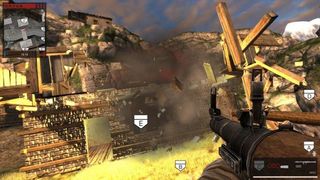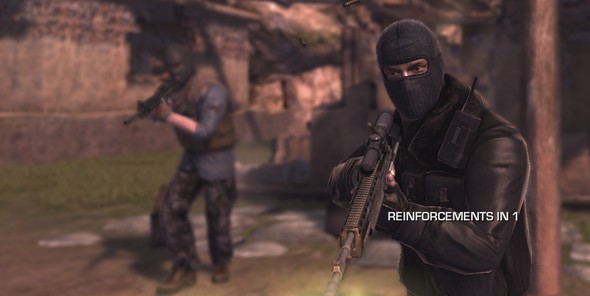Our Verdict
Excellent house-breaking multiplayer thats great while it lasts, but may wear out early due to lack of maps.
PC Gamer's got your back
There's an M60 machinegunner on the floor above me that's ruining my team's kill/death ratio. I'm carrying a sniper rifle, so storming up the stairs (which might be mined with tripwire explosives) into close-quarters combat won't end well. I check my bag of tricks for a solution, and bingo: breaching charges! I look up and tap Q to strap a gift-wrapped chunk of C4 to the ceiling. Five seconds later the section of ceiling is reduced to a hailstorm of falling rubble, spilling bricks and a player's corpse—still clutching his M60—through to the floor in front of me.

Breach handles anti-architecture warfare similarly to the way Battlefield: Bad Company 2 does it—RPGs and other bombs take bites out of bridges, wooden terraces and houses to terrify and reveal those inside. The biggest difference here is that there's more incidental cover to explode (like rows of sandbags), and Breach's latch-on cover system.
But Breach isn't just a cover-based game about killing walls—it feels more like a Battlefield from a parallel universe (which I like). Its four all-outdoor levels resemble BFBC2 design—each has a main path dotted with breakable shacks and walled in by mountains. They're great layouts, and they encourage firefights with a pace slow enough to let teams build momentum, but fast enough to keep the action hot.
Tactical traffic

Convoy mode is the best of Breach. Here, attackers try to disable two slow-moving, AI-driven vans that snake through the level by hitting them with explosives; defenders man turrets mounted on the vans, repairing the vehicles and blowing barricades that block their path. It paces just as brilliantly as Team Fortress 2's Payload mode: picking off a defender who steps away from repairing the convoy or plowing the road so the vehicles can move feels like tug-of-war with assault rifles.
The holes in Breach's design are mostly graphical. Other than the destruction physics, it feels like it's built on tech that's three or four years old—mixed texture quality and odd details like shooting a truck's tires sounding like bullets pinging against metal clash with the fidelity of blowing pinpoint-accurate holes in walls and rooftops for a clear shot. The upside, of course, is that it'll run well on most systems.

I hope Breach doesn't end up as this year's Lead and Gold. Both games are outstanding multiplayer experiences for their price, with novel bits of design that many triple-A shooters wouldn't attempt. But L&G has been abandoned due to its limited content, and Breach is similarly lean. It may not be enough to woo large populations away from the other FPSes where they've entrenched—but if you try it, it's a blast.
Excellent house-breaking multiplayer thats great while it lasts, but may wear out early due to lack of maps.

Evan's a hardcore FPS enthusiast who joined PC Gamer in 2008. After an era spent publishing reviews, news, and cover features, he now oversees editorial operations for PC Gamer worldwide, including setting policy, training, and editing stories written by the wider team. His most-played FPSes are CS:GO, Team Fortress 2, Team Fortress Classic, Rainbow Six Siege, and Arma 2. His first multiplayer FPS was Quake 2, played on serial LAN in his uncle's basement, the ideal conditions for instilling a lifelong fondness for fragging. Evan also leads production of the PC Gaming Show, the annual E3 showcase event dedicated to PC gaming.
